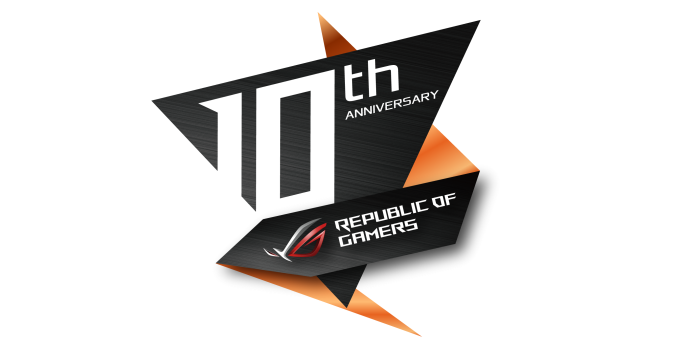An AnandTech Round Table with ASUS: 10 Years of the Republic of Gamers
by Ian Cutress on March 9, 2016 9:00 AM EST- Posted in
- Motherboards
- Asus
- ROG
- GPUs
- Trade Shows
- Interview
- CES 2016

Earlier this year before CES 2016, we approached ASUS with an idea: as the Republic of Gamers brand is now in its 10th year of operation, we wanted to get together and discuss the feeling and utility of ROG a decade on, record it, have a question and answer session from our readers, and publish the video. The Republic of Gamers brand from ASUS has been difficult to ignore, both from an engineering perspective when it comes to motherboards and graphics cards, but also the origin story, integration with users, and the expansion out to many different product lines. I felt it was important to hear from the source, and see what makes the mind tick of some of the integral cogs behind the ROG experience.
For long time AnandTech readers, you will know that very few people in this industry stay in one position – in recent times, Dustin has moved to Corsair, Vivek now works with Razer, and Anand works at Apple. I started as Senior Motherboard Editor back in 2011, when my predecessor Rajinder Gill took a position within ASUS’ technical team. His predecessor, Gary Key, is also with ASUS and currently sits as Director of Marketing for ASUS USA.
| Vivian Lien Chief Marketing Officer, ASUS USA ASUS Marketing from 2006/2007 |
Gary Key Director of Marketing, ASUS USA AnandTech Motherboard Senior Editor 2005-2008 |
Rajinder 'Raja' Gill Technical PR Manager, ASUS USA AnandTech Motherboard Senior Editor 2008-2010 |
Ian Cutress 10 Years of ROG Round Table Chair Current AnandTech Motherboard Senior Editor from 2011 |
At the time when Gary, Raja and Kris Boughton (another former motherboard editor for AnandTech) were probing the original models, Vivian was one of their direct ASUS contacts, ensuring that direct line of communication and filling them in on the details. Then when Gary joined ASUS, Raja had Gary as his main contact, and so on, meaning that for this discussion we have the ASUS-AnandTech contact line right from the initial ROG launch.
Between the AnandTech motherboard reviewing staff, we have covered the Republic of Gamers brand from its inception, with both Gary and Raja now involved in various levels with members of the team that designs, develops, tests and pushes the ROG ecosystem, then managing the perception of it as part of the ASUS brand within North America.
If we look back at AnandTech’s content history, the deep dives from both Gary and Raja into those products are still insights into motherboard design and complexity. They are certainly worth a read several years on, along with Kris Boughton’s reviews, who worked alongside Gary in 07/08. For those interested, here’s every ROG motherboard we’ve ever tested:
07-2007: ASUS ROG at Computex – Gary Key
11-2007: Maximus Formula Review – Rajinder Gill
12-2007: Maximus Extreme Review – Rajinder Gill
01-2008: Rampage Formula Review – Kris Boughton
03-2008: Striker II Formula Review – Rajinder Gill
04-2008: Striker II Extreme Review – Kris Boughton
10-2008: Rampage II Extreme Review – Gary Key
11-2009: Maximus III Formula Review – Rajinder Gill
04-2010: Maximus III Extreme Review – Rajinder Gill
07-2010: Rampage III Extreme Review – Rajinder Gill
04-2012: Crosshair V Formula Review – Ian Cutress
08-2012: Rampage IV Gene, Formula and Extreme Review – Ian Cutress
03-2013: Maximus V Formula Review – Ian Cutress
05-2013: Maximus V Gene Review – Ian Cutress
11-2013: Maximus VI Impact Review – Ian Cutress
01-2014: Rampage IV Black Edition Review – Ian Cutress
12-2014: Maximus VII Impact Review – Ian Cutress
06-2015: Rampage V Extreme Review – Ian Cutress
12-2015: Maximus VIII Impact Review – Ian Cutress
You may remember we interviewed Dr Albert Chang, Senior Division Director of ASUS Motherboard Business Unit Research and Development back in 2014 about the general path for motherboard design, and how the ROG team is designed to be that skunkworks element of engineering. Raja assists ROG’s internal impromptu extreme overclocking events with top overclockers as well as community management, so we picked his brains on how design ideas from the forums and events assist product design.
As a result of the ASUS ROG push, we end up meeting with ASUS frequently at events (much like other companies), but a round table was a great chance to get a decade of AnandTech Senior Motherboard Editors in front of the camera with Vivien Lien, the CMO of ASUS USA who was part of the team that supplied the first set of ROG motherboards we tested to AnandTech. We also posted an open Q&A pipeline, inviting questions from readers. I took the best part of a dozen of those questions for the round table.
Audio only download: MP3
Timestamps MM:SS
00:06 – Intro
02:50 – Starting with the Rampage Extreme
04:20 – How to begin a gaming focused brand
05:55 – Several years for ROG profitability, the changing nature of Gaming
07:25 – Engineering and Overclocking
09:50 – The X79 motherboard that was never sold, but helped future platforms
13:30 – Evolution of the OC Panel
14:45 – Custom hardware development and implementation
16:15 – Republic of Gamers in 2006/07: Teething Issues
18:35 – ASUS sends an engineer to Gary’s house to fix it
19:45 – Translating an issue, that needs an ASUS engineer to fix, into feedback for the future
22:13 – ROG Forums and ASUS’ official presence on other major forums for support/feedback
23:25 – Start of Q&A
24:00 – Q1 from zodiacfml: Make an ASUS ROG Smartphone!
25:35 – Q2 from jjj: What makes ROG worth the cost?
31:50 – Q3 from jasonelmore: Is $500 too much for a Z170 motherboard?
34:05 – Q4 from 7amood: Any future plans for waterproofing?
34:45 – Q5 from dreamer77dd: Will we see a dual socket ROG platform?
36:03 – Q6 from boeush: Will ASUS compete with MSI’s GT80?
37:35 – Q7 from boeush: Is there demand for larger laptops (18”+) or 16:10 screens?
38:55 – Q8 from iamkyle: Will we see customizable NICs/codecs?
41:45 – Q9 from Ian: Is there 10GBase-T on the brain?
43:46 – Q10 from Shadow7037932: How does ASUS evolve when an i7 920 still offers good performance?
45:40 – Outro
46:02 – FIN














36 Comments
View All Comments
mapesdhs - Thursday, March 10, 2016 - link
That's weird, Poland is in the EU, it should have been included for the same prizes as everywhere else...iamkyle - Wednesday, March 9, 2016 - link
My comment was answered WHAAAAT!!!!Using an extra slot is a bit of a stretch. Something tells me that the people using 2 way or even 3 way graphics won't care about losing an expansion slot. Hell, most people who build ATX or larger enclosures are wondering how they can use those slots they've paid for! It just seems that in this world, PCIe is basically relegated to either graphics, or wireless nics...especially now with the advent of m.2 NVMe.
Regardless, THANK YOU x a million for asking my question.
bill.rookard - Wednesday, March 9, 2016 - link
Well, PCIe is not quite relegated to GPUs or WiFi NICs for a variety of reasons.First up, almost all good RAID cards are PCIe x4 or x8, and of course then you'll also need the available drive bays for anyone looking to build a combined gaming/NAS machine.
Then there are the other specialized cards. Video capture cards (good ones) are PCIe. Quad wired NIC cards are also PCIe x8.
So - build yourself a good NAS/gaming system and you can easily use 2 GPUs, a RAID card, and a quad NIC (or even just a secondary NIC) for four PCIe x8 slots...
Strunf - Thursday, March 10, 2016 - link
It would be crazy to make a machine that is both a NAS and Gaming system, if it's a gaming system 3 (4 at max) PCIe are more than enough, if it's a NAS 2 PCIe are more than enough. Many boards already have like 4-6 SATA ports, 2 NICs and what not... I'm pretty sure 2 PCIe slots would be enough for like 99% of the users, it's no wonder Micro-ATX is soo widespread nowadays and probably selling a lot more than ATX.Valantar - Wednesday, March 9, 2016 - link
I love that my main desktop is still running the third ROG motherboard you ever tested, the Rampage formula. With a couple of ssds and a Fury X, it still performs great. Have to admire the longevity of both that board (the chipset gets scorching hot, but it's stable as anything) and the poor Q9450 that lives in it. I've even been pushing it to higher OCs in the last year with good results (used to use the built-in OC profiles, but I've gained another 500MHz from that). Will definitely look closely at anything ROG for my upcoming platform upgrade!mapesdhs - Thursday, March 10, 2016 - link
I really like the Maximus IV Extreme, so ridiculously easy to get a 2700K running at 5GHz, done it with six different builds so far, only needs an air cooler to work fine with good temps and little noise, though I use H80s in final builds for optimal results. Only down side is the NEC USB3 chip which is flawed, the board often ends up with dropped ports in later usage.After that, the Rampage IV Extreme is my other favourite. Bit surprised AT never did a review of this, instead just the B.E. was covered later.
Ian Cutress - Thursday, March 10, 2016 - link
We did review the RIVE. It's in the combination ROG review back in August 2012 where I did the whole set: http://anandtech.com/show/6082/asus-republic-of-ga...zodiacfml - Thursday, March 10, 2016 - link
Thanks Ian for seeing a perspective with my question for ASUS. Yet, I still do believe there is value with an RoG smartphone because there's nothing out there that caters to a gamer such as consistent FPS, long battery life, and stereo speakers. It can pre-installed with software to monitor and control RoG products such as motherboards and routers.Ian Cutress - Thursday, March 10, 2016 - link
Since the video was recorded, I've had some hands on time with the Acer Predator tablet. That felt much like what a ROG tablet might be like, in terms of looks and style at least. The hardware wasn't anything to shout too much about though.just4U - Thursday, March 10, 2016 - link
"How does ASUS evolve when an i7 920 still offers good performance?"--
I listened to the answers and one thing I wanted to point out is people are looking more and more for boards that support their still good processors. Selections for socket 775-1155 (lets not discuss 1156..) are pretty slim pickings. There's a market there still which isn't being taken advantage of and should be.
We see it somewhat on the AMD side of things (with longevity and compatibility with the AM2-AM3+) but not so much for intel stuff. The odd board here and there with a cheap chipset... (I'll give Asus a bit of credit with that older 1155 mini itx solution but ..that's about it)